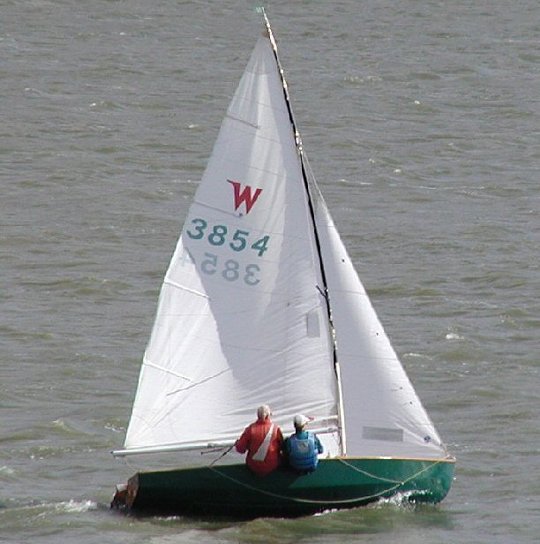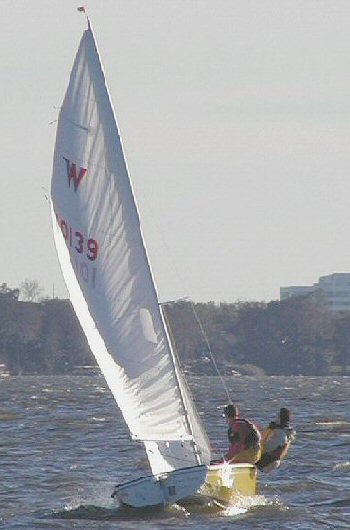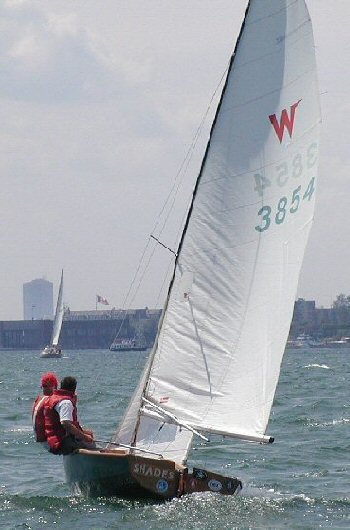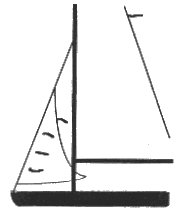|
There
are two kinds of "trim": boat
trim and sail trim. Both are relatively easy to achieve and
maintain, and both are crucial to performance. Good boat trim
is
also a key to sailing safely.
Boat
Trim: The
basic rule of thumb is
to keep the boat level - both fore and aft, and sideways. This allows a
sailing dinghy to perform as intended.
Fore
and aft: Neither the bow nor the transom should dig into the
water. Distribute your weight accordingly. On racing boats, the helm
and
crew usually sit next to each other on either side of the centre
thwart.
This means a good 3-foot-long extension tiller is very helpful as it
permits
the helm to sit forward and/or out. N.B.
On a windy reach or run when the boat wants to plane, sit well aft
(even
on the back tank!). Keeping the bow up, allows the boat to sail on its
flatter aft sections, which is much more stable, i.e. not as
capsize-prone!
Sideways:
The basic rule of thumb is to sail the boat flat - except in very light
airs where some heel to leeward may help to keep the sails from
flopping
around.
How much heel is too much? - If your tiller gives more than a slight pull to leeward, you are heeling too much (to leeward)! Why is too much weather helm bad? - You are using the rudder as a brake while slowly weakening it for the day it will finally give in to years of unnecessary strain. The helmsperson also wastes energy, wrestling with the tiller while trying to keep the boat on course. How to correct weather helm caused by too much heel? - Hike out and/or flatten your mainsail with lots of vang. If this is not enough, "rag" the main (or reef) as much as is necessary to make the excess heel and weather helm go away. Sail
Trim: All
sails perform best when
trimmed to the edge of a luff. This means steering to the edge of a
luff
when close-hauled, and letting the sails out til they start to luff,
off
the wind.
If in doubt, let it out!! A sail that is luffing loses power roughly in proportion to how much of its area is luffing. but, a sail that is in too tight stalls entirely. The boat won't crash like a plane but the power loss is nearly total in short order!
The
leech tickers are also threaded
with a needle out the back of the leech after a Figure 8 stopper knot
has
been put into the end of the 15 cm. length of wool that will end up
between
the folded layers of cloth at the trailing edge of the leech.
N.B. Be careful to position tickers so that they are in the least possible danger of catching on seams or curling around the front of the jib luff!!! How to read the luff tickers? When a windward ticker starts to flicker upwards the sail is starting to luff. This sail trim is just about perfect. If the upper ticker lifts before the lower while you sail close-hauled, the top of your jib is twisted off too much and you can sheet in some more. The reverse also applies, i.e. ease sheet to avoid lower ticker lifting first. How
to read the leech tickers?
Upwind, sheet in until the ticker starts getting sucked behind its sail, but no further!!! Off the wind (main only), tighten vang until ticker starts getting sucked in behind the leech or until the boom is more or less at right angles to the mast. Trim
without tickers? A looser jib halyard = rounder jib luff entry = lower pointing In theory, the tighter the halyard, the better you point. But of course, that's too easy because The flatter the luff entry, the narrower the groove! And it is only possible to sail effectively in a very narrow groove on waveless water in a nice steady wind, and even then, you need a very fine touch on the helm since your sail needs to be angled almost perfectly to the wind all the time. Otherwise there will be a major power (= performance) loss. As soon as conditions are less than ideal (waves, puffs, disturbed air, relaxed helm) you must widen your groove by reducing jib halyard tension (which will make your jib luff entry rounder and more forgiving while resulting in a pointing loss that you just have to live with since the alternative is much worse!). A wider groove allows the jib to function quite well even when it is not flawlessly trimmed. If in doubt, reduce halyard tension! The
importance of sufficient leech
tension, going upwind in a breeze:
 When you are overpowered upwind, the vang
does two extremely
important things: It flattens your main
by bending the mast (above),
and secondly, but no less important,
it keeps absolutely essential tension on your main leech, letting you
keep pointing even when you
have to rag the main to spill wind and keep the boat reasonably flat.

 In the pictures above, notice the leech tension we're getting (right), even from our "blown-out" old main, which in turn is bending the mast - all due to applying lots and lots of vang. On the left, only the upper mainsail is falling off, a sure sign of too little vang, and because Richard and Michele are having to spill some wind, they're getting too little leech tension. This hurts in two ways: pointing will be poor, and the mast is not being bent to flatten (depower) the mainsail. I have found this out the hard way, by getting axed in a race, when I experimented with ragging the unvanged main, having brilliantly figured out that this would luff the top of the main first and would ease a lot of the heeling forces much sooner. Obviously that had to be faster! Alas, it took less than a single beat and our having plummeted from a great, race-leading start to 9th place, to discover that the reality did not match the theory. It would be another 10 years before Mike Mac would provide me with a reason: the boat points on main leech tension. This is in fact the main reason why Wayfarers have gone to adjustable spreaders. These can be (and are, for a blow) set to help the mast resist being bent, which in turn lets you have more leech tension in the main which has to be pulled down by the vang that much harder before the mast is willing to bend, and presto, better pointing even when the sail is well ragged! |
